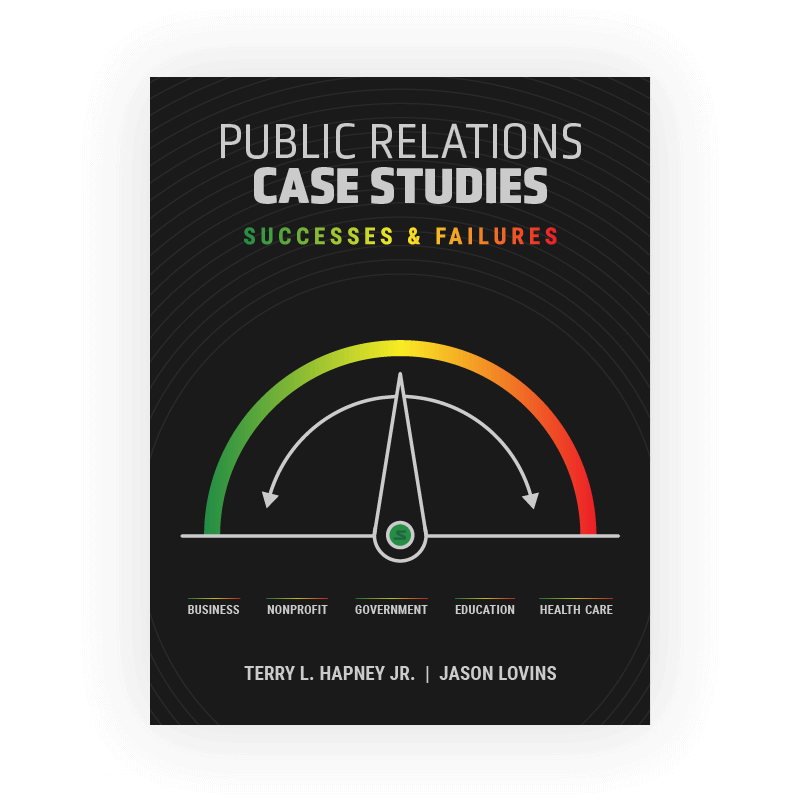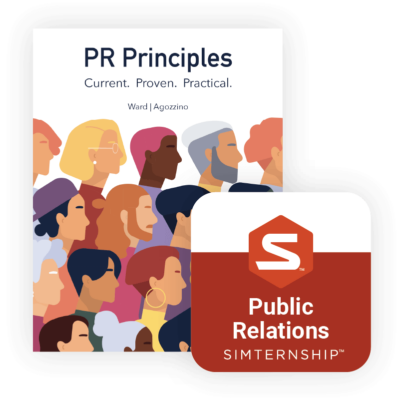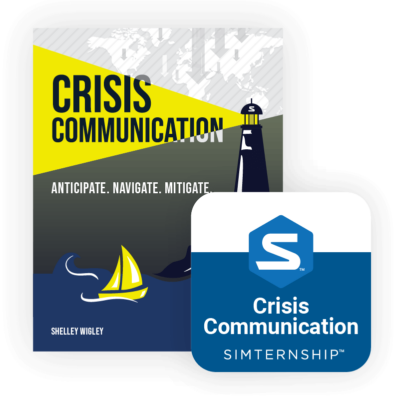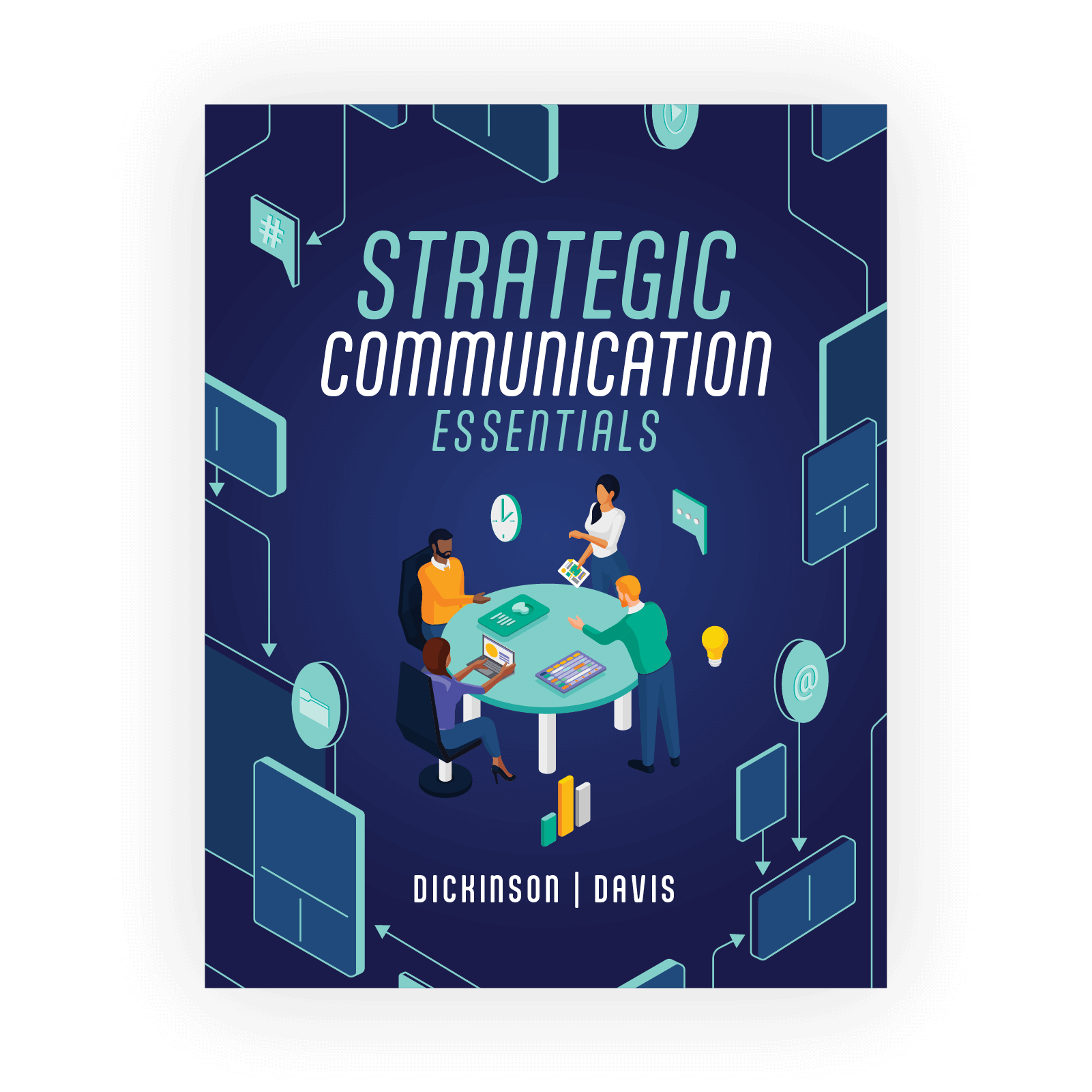Public Relations Case Studies Courseware
Powerful Insights into Real-world PR Strategies
The “Public Relations Case Studies” courseware gives you relevant and detailed real-world PR cases to help your students apply important public relations principles. It includes 12 case studies that address a range of organizational crises, including workplace accidents, product-harm situations, funding cuts, and much more.
Each case study includes an in-depth narrative of the background and scenario of the situation, a Case Analysis Tool assignment, a role-playing exercise, and “The Rest of the Story!” document that reveals how public relations professionals responded to these crises in the real world.

CHAPTER 1: The Principles of Public Relations: A Revisit
Ignite a comprehensive understanding in students of public relations history, definitions, the ideal form, strategic management, RPIE, the significance of ethical codes, and the proactive nature of the field.
CHAPTER 2: Case Analysis
Differentiate between problems, issues, and crises and evaluate decision-making in case scenarios.
CHAPTER 3: Fatality and Facebook: A Perilous Combination
Identify social media platforms that people might use to learn about an organizational crisis.
CHAPTER 4: Staying on Track During a Rail Disaster
Identify ways to address emergencies, misinformation, and crises.
CHAPTER 5: You Can’t Judge a Book by Its Cover
Build a strategy for responding to organized backlash online or in-person from an organization.
CHAPTER 6: Bad Data Breeds Bad Conclusions
Define the role of the public relations practitioner in educating key stakeholders, especially the media, about complex processes and situations.
CHAPTER 7: Taking Food from the Table: Embezzlement at a Local Nonprofit
Describe how politics can impact nonprofit organizations just as much as for-profit organizations and government bodies.
CHAPTER 8: The Painful Truth About Medical Theft
Identify ways to handle and build trusting relationships with news media contacts.
CHAPTER 9: Students Stifled Thanks to State Funding Cuts
Recognize the importance of monitoring state legislation at the discussion, development, and proposal stages.
CHAPTER 10: Not in My Backyard: Staying Nimble in a NIMBY Crisis
Define the NIMBY attitude and explain why it can be challenging for public relations practice.
CHAPTER 11: Cheers to the Chief of Police
Explain why a public official must perpetuate a certain image and brand to maintain relationships with key publics.
CHAPTER 12: A College Vice President Battles an Underground Newspaper
Discuss the significance of a strong media relations program within an organization’s public relations function.
CHAPTER 13: A High School Basketball Coach Afoul: Behavior that Crosses the Line
Recognize that it is crucial to build a strategy to address a potentially damaging situation when proactive policies and procedures fail or are nonexistent.
CHAPTER 14: Hidden Wounds from a School Shooting
Recognize the unique demands placed on everyone in a communications role during an emergency that affects nearly the entire community.
CHAPTER 1 Learning Objectives
- Recognize important facets of public relations history.
- Explain definitions that are integral to the study of public relations.
- Recognize the ideal form of public relations.
- Identify the strategic management function of public relations.
- Describe RPIE (Research, Planning, Implementation, and Evaluation).
- Discuss the importance of the PRSA Code of Ethics and IPRA Code of Conduct.
- Recognize the proactive nature of public relations.
CHAPTER 2 Learning Objectives
- Explain the importance of analyzing cases.
- Identify differences among problems, issues, and crises.
- Evaluate decisions to address a case scenario.
- Create and implement a research-based strategy to address the scenario.
- Develop an evaluation mechanism to determine whether the plan is a success or failure.
- Apply the Case Analysis Tool (CAT) to suggest appropriate actions in the presented scenario.
CHAPTER 3 Learning Objectives
- Recognize and describe the volatility of social media posts in times of crisis.
- Identify the most likely social media platforms that people might use to learn about an organizational crisis.
- Distinguish gaps and opportunities for improvement in a crisis communications plan regarding social media.
- Suggest a set of standards for employee behavior related to social media during organizational emergencies.
- Apply the Case Analysis Tool (CAT) to suggest appropriate actions in the presented scenario.
CHAPTER 4 Learning Objectives
- Discuss the importance of clear communication in emergency preparedness and response planning in any organization or community.
- Explain why staying current in emergency preparedness is so important.
- Identify typical key stakeholder groups in a community crisis and their expected information needs.
- Describe the reasons why some information in a crisis communication response may not be suitable for release.
- Identify ways to respond to misinformation, especially confusion or sensitive information spread by social media.
- Discuss the importance of simplifying complex information for an uninformed audience by focusing on the most important facts the public needs to know.
- Use a structured, logical approach, such as news conferences or media updates, to keep key stakeholder groups informed in a timely manner during and after a crisis.
- Apply the Case Analysis Tool (CAT) to suggest appropriate actions in the presented scenario.
CHAPTER 5 Learning Objectives
- Recognize the hazards and ethical dilemma of being unfamiliar with the organization’s product or service offerings when selling them in good faith to key publics.
- Explain the importance of having a plan to effectively address key publics’ concerns about a product, service, product-harm incident, or some aspect of the organization.
- Identify the repercussions of not responding to news media queries about controversial topics such as a product-harm situation.
- Build a strategy for responding to organized backlash online or in person from an organization.
- Apply the Case Analysis Tool (CAT) to suggest appropriate actions in the presented scenario.
CHAPTER 6 Learning Objectives
- Recognize the role of the public relations practitioner in educating key stakeholders, especially the media, about complex processes and situations.
- Explain how field experience in journalism can be exceptionally helpful for a public relations practitioner in producing earned media pieces.
- Describe the value in building relationship equity over time to foster much-needed trust with news media.
- Explain why respecting a reporter’s deadlines is crucial to clarifying both sides of a situation in public.
- Build a plan to address media queries in as timely a manner as possible.
- Recognize that being available to the media is paramount to reducing widespread reputational damage by correcting misinformation.
- Apply the Case Analysis Tool (CAT) to suggest appropriate actions in the presented scenario.
CHAPTER 7 Learning Objectives
- Identify what items and costs should be included in inventory and cost of goods sold.
- Account for inventory purchases and sales using both a perpetual and a periodic inventory system.
- Calculate cost of goods sold using the results of an inventory count and understand the impact of errors in ending inventory on reported cost of goods sold.
- Apply the four inventory cost flow alternatives: specific identification, FIFO, LIFO, and average cost.
- Use financial ratios to evaluate a company’s inventory level.
CHAPTER 8 Learning Objectives
- Acknowledge that transparency and truthfulness must be maintained when explaining a situation to key publics.
- Recognize that some situations will characterize your organization as guilty even when it is not.
- Craft messaging that conveys remorse without implying guilt.
- Identify questions a reporter might ask about the details of a crisis and build an FAQ with best answers.
- Realize the importance of using tough questions as an opportunity to at least provide statements about the organizations.
- Realize the importance of building trusting relationships with news media contacts.
- Apply the Case Analysis Tool (CAT) to suggest appropriate actions in the presented scenario.
CHAPTER 9 Learning Objectives
- Identify the two major categories of long-term operating assets: property, plant, and equipment and intangible assets.
- Record the acquisition of property, plant, and equipment through a simple purchase as well as through a lease, by self-construction, and as part of the purchase of several assets at once.
- Compute straight-line and units-of-production depreciation expense for plant and equipment.
- Record the discarding and selling of property, plant, and equipment.
- Account for the acquisition and amortization of intangible assets and understand the special difficulties associated with accounting for intangibles.
CHAPTER 10 Learning Objectives
- Define the NIMBY attitude and explain why it can be so challenging for public relations practice.
- Identify the research steps needed to clearly understand public perception of the organization and its actions.
- List ways a spokesperson can be flexible in delivering complex messages through multiple channels.
- Develop steps to reach out to key publics in several ways to inform them about issues potentially affecting their health and home.
- Explain why people in an emotional, defensive state of mind may remain unconvinced about the logic of taking certain actions.
- Create a strategy to address area residents’ concerns about actions that are perceived as an environmental hazard.
- Apply the Case Analysis Tool (CAT) to suggest appropriate actions in the presented scenario.
CHAPTER 11 Learning Objectives
- Explain why a public official must perpetuate a certain image and brand to maintain relationships with key publics.
- Differentiate key decisions a public figure may have to make to minimize damage to reputation in the aftermath of a crisis.
- Correlate the relationship between a public figure and media gatekeepers with successful outcomes in relationship maintenance involving key publics.
- Identify circumstances, by considering elements such as severity of blame and timing, in which taking no immediate action may be the best course for a damaged public figure’s image.
- Apply the Case Analysis Tool (CAT) to suggest appropriate actions (or not taking any actions) to repair a damaged image in the presented scenario.
CHAPTER 12 Learning Objectives
- Discuss the significance of a strong media relations program within an organization’s public relations function.
- Recognize the impact that citizen journalists and underground media have on organizations.
- Explain how ethical expectations apply to both the journalist covering an organization and to the public relations practitioner representing the organization.
- Recognize that internal publics require relationship building, repair, maintenance, and strengthening, just as external and intervening publics do.
- Analyze specific situations to determine the sources of problems, issues, and crises.
- Apply well-researched and well-planned public relations strategies and tactics to solve problems, rectify issues, and minimize and eliminate crises.
- Apply the Case Analysis Tool (CAT) to suggest appropriate actions in the presented scenario.
CHAPTER 13 Learning Objectives
- Realize how the proactive nature of the strategic management function of public relations can prevent problems from becoming issues that can become crises.
- Discuss the importance of effective internal and external communication in a school district setting, including in the task of building strong relationships with key publics.
- Recognize that it is crucial to build a strategy to address a potentially damaging situation when proactive policies and procedures fail or are nonexistent.
- Analyze situations to determine which public relations theory organizational leaders should use to address a negative situation.
- Apply the Case Analysis Tool (CAT) to suggest appropriate actions in the presented scenario.
CHAPTER 14 Learning Objectives
- Recognize the unique demands placed on everyone in a communications role during an emergency that affects nearly the entire community.
- Explain how those involved in crisis response may experience delayed trauma after suppressing their emotions to carry out necessary duties.
- Apply the principles of safeguarding confidences as presented in the PRSA Code of Ethics.
- Identify the specific communication issues that can arise in a crisis where children are involved.
- Apply the Case Analysis Tool (CAT) to suggest appropriate actions in the presented scenario.
The courseware’s materials make teaching Public Relations Case Studies easier for you and more engaging for students. The following resources are included:
- 12 Case Studies
- 24 lecture slide decks
- 14 lesson plans
- 12 live role-play exercises
- 12 Case Analysis Tool assignments
- “The Rest of the Story!” document that explains how public relations professionals responded to these crises in the real world
- Sample syllabus and course calendars
- Cumulative glossary for student reference
- LMS integration with Stukent platforms
Expand your
Definition of Courseware
Updated every year
With lifetime access for students.
100+ resources
Includes case studies, lecture slides, role-play exercises, lesson plans, and more.
The Stukent Support Team
Has a 96% customer service satisfaction rating.
Table of Contents &
Key Learning Objectives
All-new
Public Relations Case Studies
INCLUDES 1 COURSE SYLLABUS WITH

ABOUT
THE AUTHORS

Photo by Jeremy Reed
Terry L. Hapney Jr., Ph.D.
Terry L. Hapney Jr. has taught JMC 439/539 — Public Relations Case Studies — for 14 years now. He teaches this course as a seminar in which the case study is the primary mode of instruction. Terry’s course has prepped numerous student cohorts in the degree program, earning more than 70 local, state, and regional professional awards from the Public Relations Society of America (PRSA). Using the new courseware, students will work through a series of case problems by writing problem-solutions and making presentations to the class.

Photo by Jeremy Reed
Jason Lovins, Ph.D.
Jason Lovins is an experienced faculty member with a demonstrated history of working in higher education, corporate communications, marketing, and business ownership and management. A managing editor at age 23, a corporate vice president at 25, and an independent business owner in publishing for more than a decade, Jason is skilled in marketing, crisis communications, journalism, media relations, corporate communications, entrepreneurship, and publishing.
He’s a national and state award-winning PR practitioner with a Ph.D. focused in mass communication and media studies from Ohio University – E.W. Scripps School of Journalism. His dissertation focused on post-crisis business image repair. Jason has more than 35 years of professional work, including more than 5,500 published works in owned, earned, and paid media from the 1980s to the present. He also has experience in course design across multiple modalities.
Hands-on Learning without the Hassle
Stukent Simternships integrate with your favorite LMS platforms
Single Sign-on
Grade Book Syncing
Deep Linking
Rostering


Related Courses
Request Free Instructor Access
A Stukent course consultant will verify you are an instructor and send you an email to set up your account.
Take a Look at the Bundle
Have your course consultant show you around the Public Relations Case Studies courseware and resources.
Fill Out the Order Form
When you’re ready to start using the courseware, a course consultant will help you fill out an order form.


